Menu

Did you know that in the United States, farms are responsible for about 72 percent of nitrous oxide emissions? This shows how much farms affect the environment. It highlights the need for strong regulations to curb negative impacts. These laws aim to protect the environment from harm. But, they are also hard for farmers, especially those who make less than $25,000 a year.
In the last fifty years, farming in the U.S. has significantly become more productive. This growth is thanks to the heavy use of chemicals and high farming intensity. However, these practices have caused problems like more greenhouse gases and polluted water. So, there’s a big need for rules that protect our environment, aiming for farming methods that are good for nature. But, following these rules can be very expensive for farmers. This cost includes buying new technology and equipment. It also involves dealing with changes in the market and what customers want.
Sometimes, the impact of these rules is different for big and small farms. Though only a small number, large farms produce most of the country’s crops. They have more money and resources to deal with the costs of these regulations. Smaller farms, on the other hand, find it much harder. They often face a challenge in keeping up without enough financial help.
Environmental regulations are critical in farming. They protect nature, secure our future food, and keep us healthy. Rules cover contaminants like nutrients and pests to safeguard water, soil, and air quality.
In the United States, major laws guide farming’s environmental impact. The Clean Water Act minimises water pollution, affecting how farms handle waste and fertilisers. The Environmental Protection Agency sets standards to control air pollutants from farming activities.
| Regulation | Focus Area | Implications for Farmers |
|---|---|---|
| Clean Water Act | Water quality | Monitors pollution from farm waste and fertilisers |
| EPA Air Programs | Air quality | Lessens harmful emissions like ammonia and methane |
| USDA’s Conservation Reserve Program | Land conservation | Promotes managing land wisely |
Farmers must know the agriculture sustainability regulations well. Being aware helps manage farms better. It’s key to avoid fines or losing market chances. It also guides towards more sustainable farming practices.
Caring for the environment benefits farms in the long run. It’s about using the rules to improve soil, save water, and keep the ecosystem healthy. This both preserves the future and boosts farming’s bottom line.
Over time, rules and systems in farming have changed a lot. This is due to the rising awareness about the environment. We know this from looking at 6,123 different policies across around 200 countries.
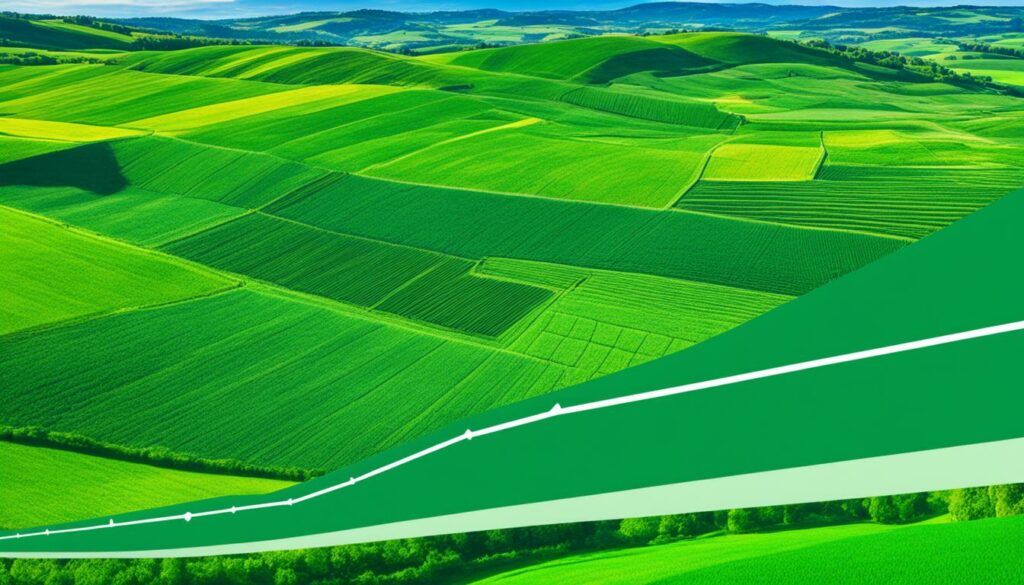
Starting in the 1960s, efforts in sustainable farming took off. Different rules were put in place to protect nature and the climate. This includes rules about how much fertiliser to use and how to look after forests and wildlife. Europe has been leading in making these green rules, but African countries are not as quick to act.
These green rules have really changed how farmers do their work. For example, they have to manage animal waste better now. This is good for our water, as it makes it less polluted. Plus, farmers are working to save soil from washing away. They do this by changing how they plant and care for their fields.
When it comes to money, these rules can make farming cost more. This is because farmers need to invest in new ways of doing things. But, the goal is to help farms be strong in the long run, even when there are tough times. Also, following these rules can help farmers make more money. This is because they are paid to protect nature while they work.
| Region | Total Policies | Common Policy Type | Targets |
|---|---|---|---|
| Europe | Most Implemented | Command and Control | Fertiliser Use, Biodiversity |
| Africa | Least Implemented | Varied | Soil Conservation, Water Use |
Farming has changed a lot due to these rules. Fields are used differently now, and people are careful to use fewer harmful chemicals and gases. The past tells us that moving towards greener farming is very important for our future.
Environmental regulations greatly influence farm practices, especially in handling water, air, and soil. Knowing the requirements for each resource is key. This knowledge helps farms meet these standards.
Rules for water quality are important for stopping pollution in streams and underground water. The Clean Water Act says farms must use the best methods to cut water pollution. Programs like the Conservation Reserve Program offer money to help. Following these rules keeps farms in line with the law. This way, they protect water and keep their earnings steady.
Keeping air clean is also crucial. Emissions like ammonia and methane need control. The Federal Insecticide, Fungicide, and Rodenticide Act lays out what farmers should do. Getting help from groups like the Agricultural Research Service is common. They offer advice on reducing pollution from farming.
Managing soil is vital for its health and for long-lasting farming. The rules say farms should use methods like conservation tillage and plant rotation. The Environmental Quality Incentives Program supports these practices. Good soil care means more fertile land for the future. This protects farm profits and the planet.
Government entities also support farmers through education and technical assistance programs aimed at improving environmental quality.
Many regulations affect farming, but they are vital for the environment and farm earnings. Understanding and following them helps keep a balance. This supports farming that’s good for the economy and nature.
Environmental laws directly affect farms’ finances. They must invest in new tech and change how they operate. These steps are vital for both meeting environmental goals and staying profitable over time.
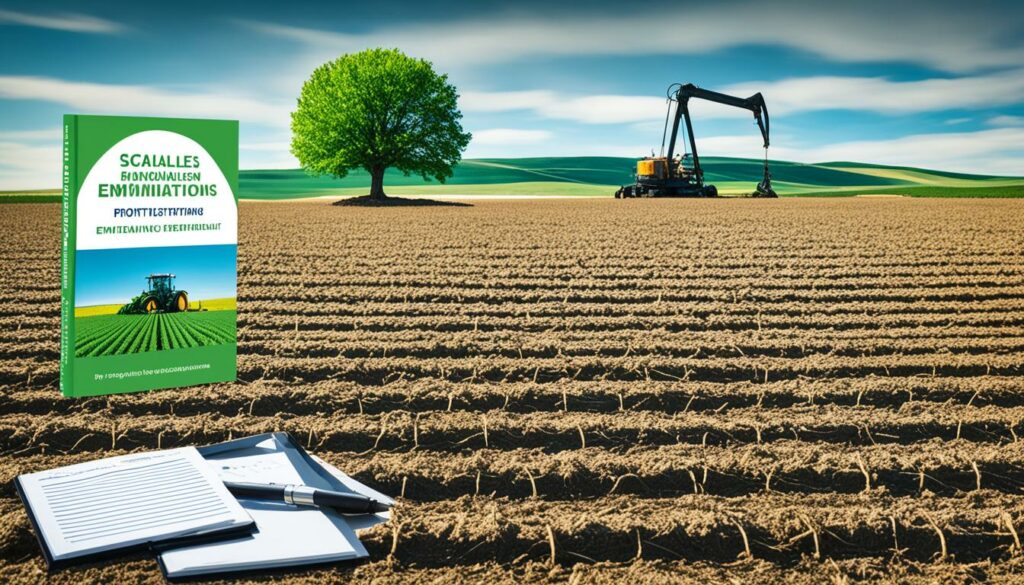
Meeting these laws involves buying and setting up new tools, and using better farming methods. It’s about using methods that protect the land, like conservation tillage, which can cut soil loss by a third. Yet, these ways need special tools and training. For instance, in 2001, corn farms using CRM spent $1.78 for every dollar they made, showing these methods can be costly.
Following the laws affects the economy in more subtle ways. It ties into how people buy, and what they think of eco-friendly products. Even though there might be big costs upfront, there could be big wins later. Abiding by these laws might mean more demand and higher prices for green items. For example, companies listed in the Dow Jones Sustainability Index saw their worth jump by 85% more than the market overall. This shows being green can pay off.
Besides making money, cutting back on chemicals and improving techniques could lower costs. Research shows that using CRM can save on work, tools, and fuel. It’s about spending less to get similar or even better results. This shows farm financial health in the long run is about more than just the first, big spend.
| Type of Cost | Impact on Farms |
|---|---|
| Direct Compliance Costs | Cost of new machinery, training, biosecurity measures |
| Indirect Economic Effects | Potential market premiums, reduced input costs, improved efficiency |
| Conservation Tillage (CRM) | Financial Impact |
| Average Total Resource Costs | $1.78 per dollar of output |
| Cost Savings on CRM Farms | 31 cents lower compared to non-CRM farms |
Farmers who go for sustainable choices often end up spending less in the long run. By using fewer chemicals and working smarter, farms can be less harmful to the land and grow well. So, the true impact of green rules is financial. It’s about spending now to save and earn later.
Environmental policy is key for farms to grow in a sustainable way. It pushes farmers to look at the good they do for the environment as well as making money. This balance is crucial for steady development. It’s particularly vital in places like China, facing resource shortages and high environmental strains.
Finding the right mix of making a profit and being eco-friendly is tough. Policies must look at both short-term gains and long-lasting benefits for the planet. Research in China has shown that smart environmental rules help the country grow in a green, lasting way. By managing land better, the negative effects on income from being green can be lessened, finding harmony between making money and keeping nature healthy.
Looking at real examples can illuminate how to do sustainable farming right. From 2000 to 2010, China made many rules to stop farm pollution. These efforts have led to better farming methods. Studies suggest these rules have helped bring new, green farming tech into play. This shows that strong environmental laws can make farming both green and profitable.
In Europe, efforts like this have dropped the use of harmful chemicals. But they’ve kept food production high and helped save wildlife. This success points to the need for both money incentives and skills to make a farm both profitable and eco-friendly. Farmers from around the globe can pick up tips from these cases, adding sustainability to their own farms.
The impact environmental regulations farm profitability varies between small and large farms. Each farm size faces different challenges and advantages when following these rules.
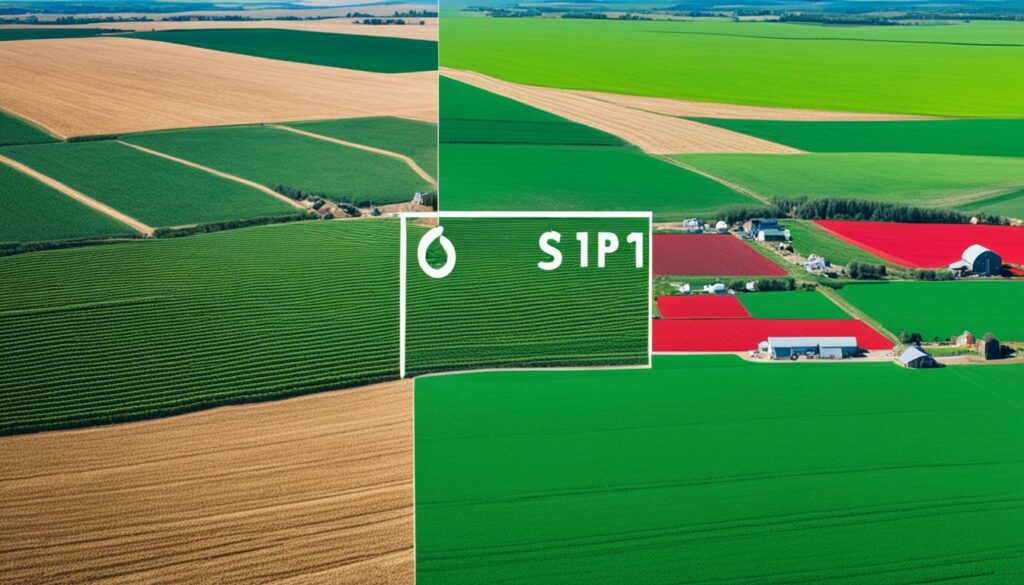
Small farms have a hard time meeting strict environmental laws farm economic viability. They lack the resources to invest in green practices. Smaller farms, under 50 acres, usually have enough surface water. But about 20% of them are in dry areas with little or no water, which is a big issue.
Adding to their difficulties, the Sustainable Groundwater Management Act (SGMA) is tough for them. It’s hard for these smaller farms to be part of plans to save water. This is because they don’t have the time or money for long meetings about this.
| Farm Size | Surface Water per Acre | Acreage Reduction in “No Trading” Scenario | Water Demand |
|---|---|---|---|
| Under 10 acres | Varies | 13% | 180,000 af/year |
| 10-50 acres | 2.2 af | 13% | 1 million af/year |
| Over 2,000 acres | 1.5 af | 22% | Varies |
In contrast, large farms have it easier with environmental laws farm economic viability. They can use their size to lower the cost of meeting these laws. They can also get more money and resources, so they invest in the latest tech. This helps them follow the rules and do good for the environment.
On average, these big farms have 1.5 af of water per acre. This water amount allows them to use smart ways to water their crops. It lets them keep growing, even if they have to cut down on their land by 22% in certain situations. Their ability to change and find new solutions helps them stay profitable while keeping up with the environment-friendly rules.
The difference in how impact environmental regulations farm profitability is felt by various farm sizes shows we need different rules for different farms. This ensures all farms, big or small, get the support they need.
Farmers need to follow the best methods to keep up with the rules. This means they should work in ways that are good for the earth and follow laws. Doing so helps them earn more money by farming the right way. It also stops fines and keeps the environment healthy.
To work well with the farming laws, it’s crucial to do things wisely. Farmers should change the types of crops, till the soil less, and use better ways to fight pests. These methods help the land, save money in the long run, and fit the rules.
“Farmers need to see environmental regulations not as a burden but as an opportunity to innovate and adopt better practices,” remarked a spokesperson from the Environmental Working Group.
Technology plays a big role in following the law correctly. For instance, using high-tech farming methods can save water, fertilisers, and pesticides. This helps reduce the farm’s impact on nature. Plus, keeping track of data helps prove that rules are being followed.
Working together can make a big difference, especially for small farms. It allows them to buy and use high-tech tools together. By sharing costs, the farming community can face the challenges of the law together. This makes working according to regulations easier and more affordable for everyone.
Using these methods together shows that being prepared for the law is good for business. It makes farming greener and more profitable. This is the real key to making money in farming today while looking after our planet.
Farmers often worry that following environmental laws might hurt their profits. But, many case studies show that farms can do well while meeting these rules. The key is to link their environmental efforts with making money.
The Bonneville Power Administration is a great example. They saved a lot of money in 2020 by working from home and using less paper. This shows that being eco-friendly can boost profits when done smartly.
Also, Central Arkansas Veterans Healthcare cut down on waste by composting. This move helped them follow the rules and save money. It proves the benefits of being eco-aware and how it can lead to saving cash.
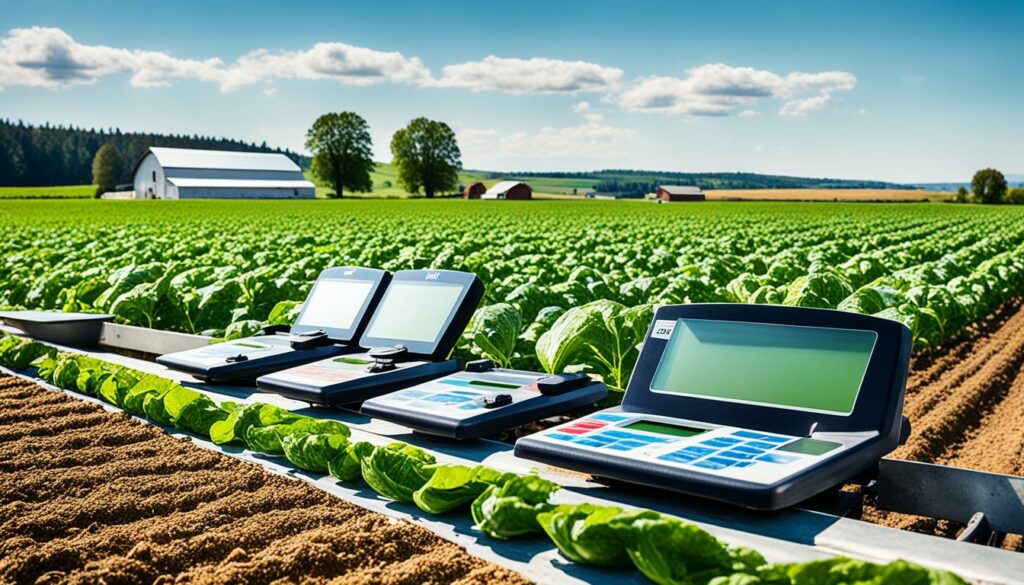
The Drug Enforcement Administration’s Western Laboratory also saw big success. They recycled a lot more electronics in 2019 than the year before. This shows that little changes can make a big difference in both money and environmental gains.
From these stories, we learn that being quick to add green practices can win. The Presidio Trust’s better waste management effort is a good example. They improved their trash sorting a lot just by making some changes.
Choosing cheap ways to be green is also very important. The Minneapolis Veterans Affairs Health Care System saved a lot of money by printing double-sided and using less paper thanks to digital records. Such smart moves can make following the rules easier and cheaper. Plus, it saves money.
Lastly, people love products that are kind to the earth. When farms focus on both making money and being green, customers notice and like it. This can bring in more loyal customers and grow the market for their products.
So, these accounts show us that finding new ways to follow the rules can be good for the earth and the pocket. Businesses that get smart about going green can see many advantages.
The financial impact of environmental regulations on farms can be big. It affects both the money a farm makes in the short run and its long-term benefits. It’s key for farmers to understand how regulations influence farm profitability to handle these changes well.
Meeting environmental rules can be costly in the short term. Especially if big changes are needed on the farm. These changes often involve new tech, changing how the farm operates, and more costs for checking and reporting on rules. Farms might need to buy advanced systems to manage waste better or use cleaner ways to farm, all to cut pollution. Though this can lower profits at first, it’s necessary to follow the rules.
The cost of following rules may look daunting at first. But, there are many long-term financial benefits. One big plus is that farms become more efficient, which cuts costs over time. Using methods like crop rotation and keeping the soil in good shape can mean more crops to sell and less spent on fertiliser. Plus, following rules can bring in new customers. More people are wanting food grown in eco-friendly ways and are ready to pay more for them.
There’s also the benefit of being ready for hits from bad weather and pests. Farms that use sustainable methods are often stronger when facing these issues. This means less financial worry. This is super important where rules on the environment are strict, as it helps farms deal with these pressures better.
It’s vital for farmers to see how farm financial impact regulations work over time. Making their farm sustainable can help not just with rules but also with making more money in the long run.
Understanding both the short-term money challenges and the long-term gains is key for farm success. It helps in planning for a farm that not only makes money but also keeps going strong for years to come.
Governments are key in supporting farmers to farm sustainably. They offer subsidies and incentives to cover expenses and promote eco-friendly farming. It’s important to see how these help farmers.

Subsidies help farmers follow environmental rules without losing money. Governments give money to help farmers do sustainable farming easily. Studies showed that farmers like programs that help them make quick money from their efforts more than those that only protect the environment.
Incentives are more than money. They give prizes for helping nature. This makes saving wildlife and using less harmful chemicals worthwhile. The research found that 36% of these focused on tech fixes, with equal parts helping ecosystems and communities. To make incentives work, we need to look at all sides, like making money, saving nature, and helping people.
We still don’t fully understand how incentives link to farmers using the best ways to farm. More studies can help us improve how these programs work. This will help farming stay profitable and green under the law.
| Type of Intervention | Percentage of Programs |
|---|---|
| Technical Intervention | 36% |
| Ecosystem Interventions | 32% |
| Socioeconomic Interventions | 32% |
Incentives and government help make farmers pick eco-friendly ways. Making these programs better is key to happier farmers and a healthier planet.
New tech is changing farming, making it easier to follow green laws. It helps farmers do well without harming the environment. This way, farming stays profitable and follows rules.
Precision farming is a big change in how farms work. It uses GPS and sensors to use water, fertiliser, and bug killers just where they’re needed. This cuts down waste and sticks to the rules, helping the environment.
Farmers can do more, while being careful about the planet. They can make sure they don’t waste resources and still meet tough rules on the environment.
Sustainability is the key to the future of farming. Innovations like making compost and using anaerobic digesters to manage waste are helping a lot. For example, digesters turn animal waste into energy, helping lower pollution.
These steps are not just good for the planet. They also make farms work better, keeping them in line with the law. By being smart about waste, farms can do their bit for the environment.
Putting new farming tech to work is important for the future. China has shown that by following green rules, farms can get better. Using these new methods leads to more efficient farming and helps the environment.
| Technology | Benefits | Compliance Impact |
|---|---|---|
| Precision Agriculture | Optimises resource use, reduces waste | Ensures adherence to legislation, promotes sustainability |
| Composting Systems | Improves soil health, reduces landfill waste | Minimises environmental impact |
| Anaerobic Digesters | Produces renewable energy, reduces GHG emissions | Meets compliance requirements, enhances operational efficiency |
These new farm techniques help with both being productive and following the rules. They show that farms can do better by not just making more, but by doing it the right way. Learning about and using these new ways can help farms make money and still meet the rules.
Farm financial success is closely linked to complying with environmental regulations. By following these rules, farmers can avoid fines and protect their image. Compliance makes a strong case for good, sustainable practices.
Adhering to environmental rules helps protect farms financially. It stops big fines and keeps the farm’s good reputation. For example, efforts to lower pollution not only follow the law but also make the air cleaner, which is good for the farm.
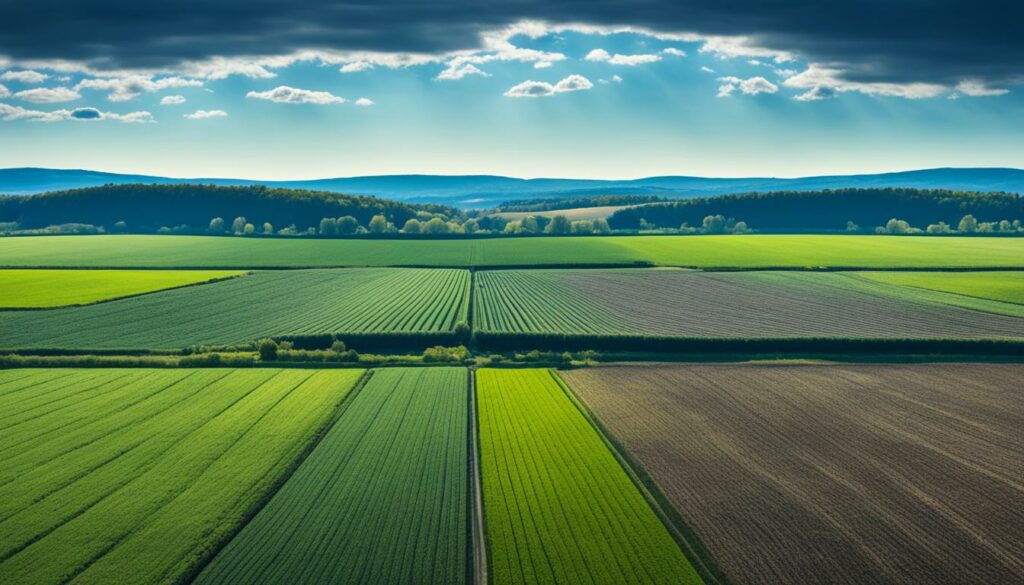
A study of 18,000 papers found farmers are more likely to comply when there are economic benefits. So, linking money to these regulations’ demands is key. It helps farmers stick to the rules.
Making farms sustainable can bring big financial rewards. Using methods like precision farming and going organic boosts farm output while cutting costs.
The 2012 Agricultural Census shows big farms lead in using these methods. They own two-thirds of U.S. farms and can spend more on these technologies. This investment pays off in the long run. Smaller farms, although facing more challenges, can still win by working together and with others.
| Farm Size | Percentage of Total Farms | Contribution to Agricultural Production |
|---|---|---|
| Large Farms | 4% | Two-thirds |
| Small Farms | Two-thirds | One-third |
Sustainable farming also fights climate change. Dairy and beef farms, for instance, have cut down on harmful gases, which is not just good for the planet but also saves money.
Using eco-friendly methods can increase farmers’ earnings. The right, precise farming with proper incentives helps farms flourish despite regulations. This not only keeps the operation green but also profitable.
Environmental rules and farming go hand in hand, affecting farm incomes in many ways. Yet, following these laws leads to big wins. It means farms work on cutting down on harmful gases, better handling their nutrients, and using less fuel. This helps the planet and the pockets of farmers.
By managing crop nutrients better, farms can drop emissions from things like nitrogen fertilisers. This fits with the aim of environmental policies and boosts farm profits. Plus, not tilling the soil can cut down on types of pollution linked to burning fossil fuels. This is a win-win for farms and for the environment, showing that eco-friendly ways can pay off.
The idea of cap-and-trade is also out there. It could bring in extra cash for farmers, showing once more how being green can mean more green. Helping farmers go greener are things like national programs and laws that reward these efforts, like the Renewable Fuel Standard.
Caught between doing good for the planet and making money, farming is changing fast. The key is to keep learning, act, and work together. This will help farmers deal with today’s issues well and set the stage for a profitable and green future for American agriculture.
Environmental rules can hit farm profits in many ways. Investing in new tech or changing how we farm to meet rules is a direct cost. Indirectly, we might see changes in what buyers want, favouring green choices.
Water quality rules are big, aiming to cut farm runoff. Then, there are air rules to limit gases like ammonia. Soil policies also matter and push for good practices such as conservation tillage.
Over the years, farm policies have changed a lot to be more eco-friendly. Today, farms have to manage their waste better and farm in ways that protect nature. These changes aim to lessen the harm farming does to the environment.
Smaller farms can struggle more because they have less to spend on greener tech. Larger farms often find it easier with more money and big-business advantages. They can handle costs and innovate more easily.
Going green in farming can bring many good things. It can make the soil healthier and cut costs. Farmers may also stand out in the market and be ready for any tough times thanks to tough, but important, environmental rules.
The government steps in to help by giving money and other benefits. This makes it cheaper for farmers to go green. It helps everyone, since farming better protects the environment.
Technology like smart tools and eco-friendly systems is a big help. It makes farming smarter, using less and helping the environment. These techs also boost how much farmers can make.
Following the green rules can save farms money by steering clear of fines and keeping up a good image. Growing crops and raising animals in a green way can also make more profit. This is because it improves how efficiently farms run and what customers think of their products.
At first, following the green rules might cost more because of new changes and tech. But in the long run, farms can see savings. They might also farm better, spend less, and get stronger. This means they can keep on being successful in the future.